|
|
This page is about
The SAFE Ham Net
|
and want to know how to contact Ark Two then click here.) |
|
|
|
|
|
and want to know how to contact Ark Two then click here.) |
|
|
|
of Preparation for Survival
1. Store food and water |
|
1. Contact --- 2. Contemplate --- 3. Communicate |
|
|
|
|
1. Know WHO to contact. 2. Know WHAT to contact them about. 3. Know HOW to contact them.
|
|
that I put this statement front and center In a developing crisis, when all media is down or does not have any current on-the-ground action reports and all you know then is what you can see & hear from your front porch, wouldn't it be great to have an ear to what's really going on, on the ground, over there?!? That's where your shortwave radio pulls in all the breaking action from independent eye witness sources up close and in the thick of it!! Everytime there's been a big disaster, it is always the hams with their radios getting the first word out to everyone else outside! Being tuned in to them then is like being the only guy with a flashlight in a black out, to really know what's going on outside of you immediate range of sight and hearing! Below is a list of some inexpensive radios and where you can get them and also the frequencies you'll want to write out and tape onto your rig.
|
|
|
|
|
|
|
At this point - I would like to introduce you to:
Greg is the Ark Two Ham TEAM Leader. Also - in Ham terms, my Elmer and our Ham guru.
|

|

|
We feel that the view here in the village, from Greg's Ham Shack, should be the envy of city dwellers - but I am not sure, given the difficulty that I have in getting people to move out of the city. |
|
This is Greg's Ham Shack from the outside -
and is from where we conduct our monthly
over the air Ark Two / SAFE Ham get-togethers. When Ark Two
goes into crisis mode we will be using the shelter location
which is located on one of the highest points
in Southern Ontario. There we have powerful diesel generators for power and a tower
from which to beam our signal down over the US.
|

|
|
When There Are So Many???
The scale of catastrophe for which the SAFE Ham Net is being developed would even swamp all current Ham organizations, none of which are designed for a catastrophe of this scale. That is why the SAFE Community needs its own specifically designed Ham Net. Through the SAFE Ham Net the members of the SAFE Community could be informed of the extent of catastrophe - and the situation in other locales at a time when the information would not be available from elsewhere. This could be especially valuable in regards to coordination of the existential matter of obtainng supplies - and regarding local threats / surrounding security problems. It could also provide information regarding the situation of family - in distant places. In the collapse of conventional means of communication such basic information as weather forecasting and road conditions and general news of what is happening may well be available only through this source. Those who are committed to the SAFE principles of preparation for survival will be aware that Ham equipment will be one of the most valuable tools which they can have for survival.
|
|
|
|
|
|
What will be described here is a system that any SAFE member can obtain - and use to listen in at any time - without a Ham license. At the time of the Catastrophe there will be no restrictions on their using the equipment to contact the other members. Of course - if they desire to use the equipment ahead of time for transmitting - for practice and to get experience - they will need to get a HAM license. As people get the equipment, for those who express an interest in getting a Ham license - I will explain a much simplified method for doing so - over what has been involved in the past. Yes, it would be good to get a license - and to practice using the equipment ahead of time, but that is not nearly so important as having the equipment available.
|
|
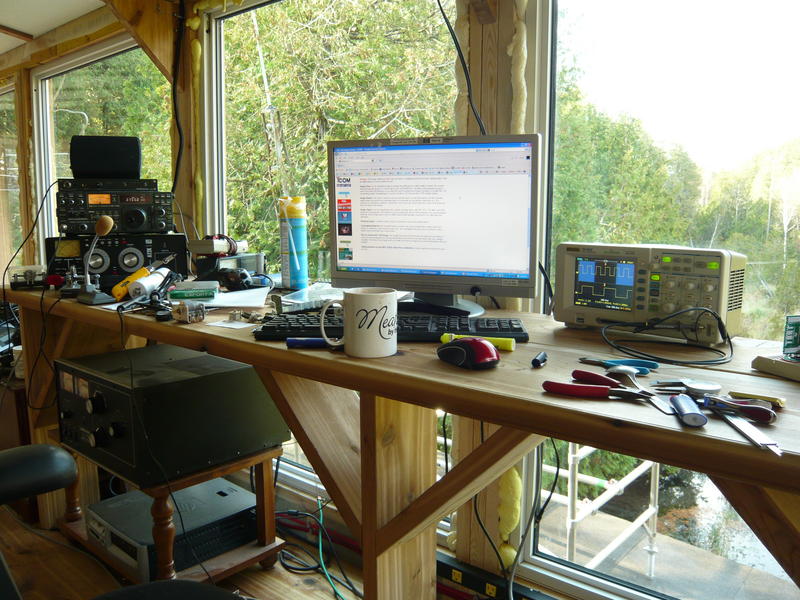
|
Extreme simplicity
Compare it to Greg's rig pictured here. Look at the center of the desk, then at the left of the desk, and down below the desk on the left. Scary! Unless you are a Ham hobbyist you really don't want to have to learn how to twiddle all those knobs. Simplicity is as simplicity does - and this is why while the SAFE Net transceiver will work on only one channel - it will do what we need it to do.
|
|
|
|
|
|
POWER
|
|
Because of the situation that we are talking about using SAFE Ham Net radio system in - it will probably be the case that you won't have a working power outlet in your house to plug your desktop computer into. But not to worry. There are probably going to be lots of car batteries around - in non-working cars.
|
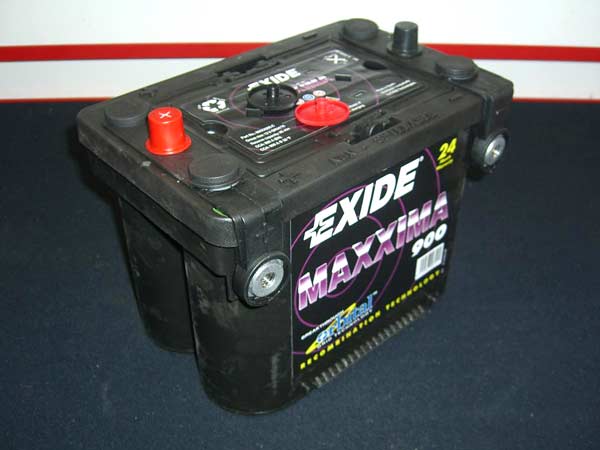
|
The proposed radio itself, won't take much energy - and it will run directily off a car battery like this one. In fact the battery doesn't need to be nearly this big. A motorcycle battery or any good 12v battery will do. More critical will be the challenge to keep the batteries charged. If the cars are working - then you will be able to charge the batteries - after you use them - even if the roads are such that there is nowhere to go (if you did have the gas). and you will probably be able to find enough gas in non-operating cars - to keep the batteries charged.
|

|
If you are going to use a computer
that presently runs on an outlet in your house -
then to use a car battery to run it -
you will need an inverter. Check the Internet - and you will find them for $13 up. You should find something suitable locally - (ahead of time) for well under $80.
The GE DC-AC Power Inverter Notice that it has a continuous power rating of 150 Watts and a peak power rating of 300 watts. Whatever you get you will have to match to what your computer, hard drive, and monitor draw.
|
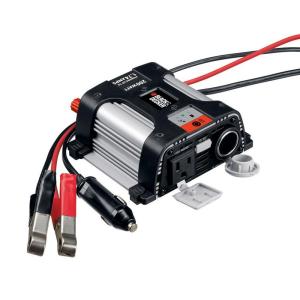
|
Here is another Power Inverter The BLACK & DECKER 200-Watt Model # PI200AB again under $40. This one has connectors both to plug into a car cigarette lighter - or clips to hook directly onto the battery. Other ideas for sources of power would be solar cells. But power is power - and if you have it you can probably find a way to convert it to your needs. Power Inverters are handy things to have. You may have one already, for some other purpose. Just make sure that it matches the power requirements of your computer.
|
|
You will also need an antenna.
This is something else
that you should get the materials for locally -
ahead of time. Most any kind of good solid wire will do.
We saw some 100 ft spools down at the hardware store for $2 a spool.
You would need two - and that means your antenna would cost four dollars.
If you get the two 100 foot spools - you will only use 60 feet off each one of them,
but you need 60 foot pieces of continuous unbroken wire. You can also buy commercial antennas that are considerably shorter and I hope to add here in the future - further antenna information. You also need a connecting wire. Do you remember that old brown flat wire - with one lead on each side of it - that you used to use to hook up the TV to the antenna? That is exactly what you need. Or, better yet, some 75 Ohm Coaxial cable as shown in the drawing, and which is like what is used to hook many TVs.
|
|
|
The drawing also shows insulators. Those are necessary -
but can be made out of plastic or glass bottles - or something.
It might be nice to have something like turnbuckles
to put in between the end insulators and the trees, in order
to take up the slack. I say trees, because you can just string this in between a couple of trees or the corner of some buildings - or any old thing rather than poles so long as they are at least 120 feet apart. The antenna does not have to be extended out in a straight line. It can have more than one dog leg.
|
It is good to have the drop line as close to you transmitter as you can. This is a non-directional antenna - so laying the two leads out in any direction - will probably work just as well but you want the antenna to be between 8 and 16 feet above the ground. Twelve feet would be ideal. The antenna may work nearer to the ground than 8 feet - but not so well, and below 8 feet there is the possibility of someone touching it and getting burnt.
|
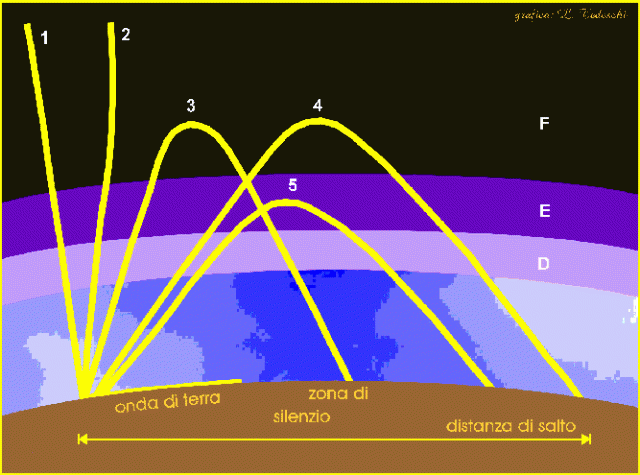
|
Some radio waves travel in a straight-line or what we call line of sight or perhaps in a 'ground wave'. Others bounce off various bands or strata in the stratosphere depending upon their frequency. We have give much careful thought as to the choice of frequency, the type of signal to send, and the construction of the antenna to meet our needs of simplicity, low cost and dependability. The chosen design will be able to reliably broadcast and receive out several hundred miles. It will also be able, depending upon such things as weather conditions, be able to oftentimes send and receive at much greater distances. However, using the net and employing nodes that have greater capacity for relaying - we should have reliable communication over great distances.
|
|
|
|
|
|
Software
|
|
|
|
The MARVEL that makes all this work - is your computer and software. It is because many of the functions of the radio are performed by your computer - that you don't have to buy an expensive radio.
It is because the computer
b. translates the message that is received in the Morse like code - into text that you can read and save in a computer file. Consequently, through the new software and coding techniques there is a great degree of error correction and reliability built into the signal that wouldn't be there otherwise. You can read all about this but it is not necessary that you understand the technical details of what makes it possible for you to use the efficiency of Morse Code as to reliability and distance - without actually having to learn it.
|
|
You Don't Need a Ham License and you don't even have to have a radio!
|
It is all very simple. In application you would be able to see the messages from many SAFE members around you and conversely one SAFE member may have his message read simultaneously by many other SAFE members. It would probably be the case that many more members would be watching than would be transmitting at any given time. Across the band there are many specific frequencies and a convention can be set up in any area that certain people will transmit on certain frequencies and at specific times. In this way the probability of reliable communication is greatly enhanced. Most of the demos are what I consider the usual boring Ham dialog - "I hear you - do you hear me?" But anyway - you can see how it works and how we can use it for the SAFE Ham Net. The baud rate being actually 31.25 means that works out to about 50 words per minute or two hundred and fifty characters per minute. 4 minutes to send a thousand characters. Forty minutes to send 10,000 which is about the length of one of my newsletters. In other words it would take about forty minutes - to receive the newsletter - so it means that we aren't going to be sending something that long. The answer is - to send very important info - and to use a lot of abbreviations. One station can send - and lots of stations receive at the same time. It is taking us much longer to develop the system than we imagined it would but we are also making further improvements as we go along. We hope that one of those improvements is an improved and even more simplified software system, but more about that if and when we make some actual progress on it.
|
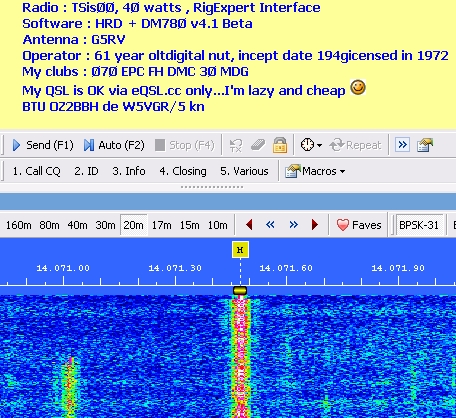
Another Rig -
|
|
Ark Two on HAM Radio AFTER the Catastrophe (if you are not a part of the SAFE Ham Net) Ark Two will monitor the band (note singular) appropriate to propagation conditions at the time. 80/75 meters LSB (LSB = Lower Sideband; the world standard) If possible, Ark Two will TX an SSB or CW beacon on an appropriate band so others can find us. We will ID as ARK TWO. Reply on beacon frequency in SSB or CW when our carrier drops.
40 meter LSB Generally, 40 meters is a good daytime band until perhaps 4PM, and then 75 meters picks up. 20 meters is a long-range band used for long haul, and counts on bouncing off the ionosphere and reflecting back, as does most amateur communication. The operator must understand propagation and skip, the factors that affect them, and know how to select the proper band based on numerous factors. 10 meters and 15 meters are the bands most affected by the eleven-year sunspot cycle. We are about 18 months from the bottom of the cycle, which is the most difficult times, in about 6 years we'll be at the peak of the next cycle, and the higher frequency bands will work. Now it's very rare to be able to make other than very local contacts on 10 and 15 meters, and this will only get worse until the sunspot cycle picks up. When it does get near peak, though, small amounts of power can talk around the world with simple antennas. The above are the type of reasons that we are mentioning "appropriate to propagation conditions". There may be other conditions caused by EMP, widespread nuclear activity, and earth changes. Whatever, we will be looking for people calling the tactical sign ARK TWO, and the call sign that we respond with will depend upon which of our HAM radio operators are present - providing that is relevant.
|
|
|